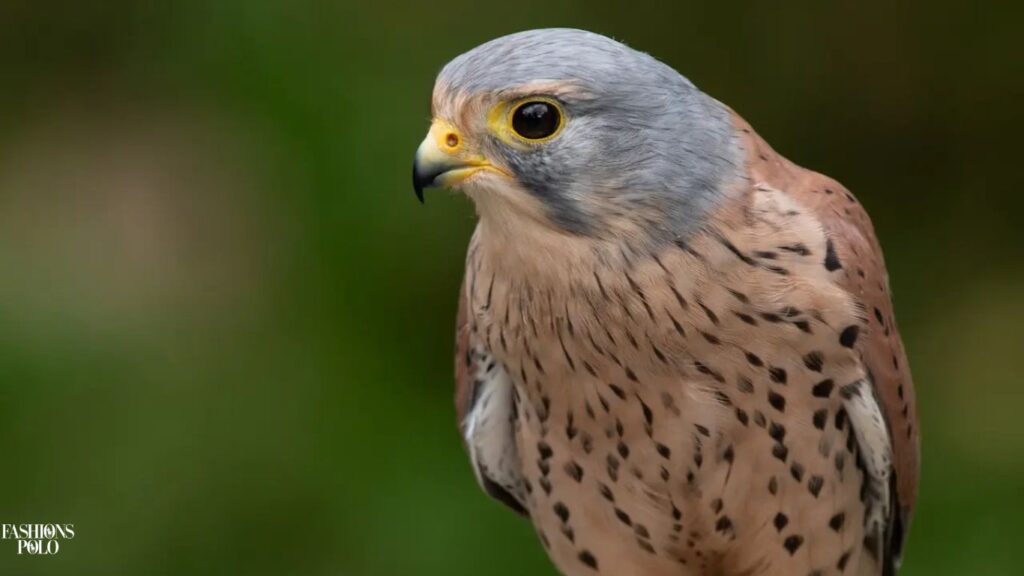The Eurasian Kestrel (Falco tinnunculus) is a small but fascinating raptor. It’s known for its distinctive hovering flight and widespread distribution across Europe and Asia. This article explores various aspects of this remarkable bird, from its appearance to its conservation status.
Eurasian Kestrel Facts
The Eurasian Kestrel is a small, distinctive falcon. It shows clear sexual dimorphism in coloration. These birds typically live 4-5 years in the wild.
Size and Appearance
The Eurasian Kestrel is a small falcon. It measures 32-39 cm in length with a wingspan of 65-82 cm. Males typically weigh 136-252 g, while females are slightly larger at 154-314 g.
These birds have rusty-brown upperparts with black spots. Their underparts are pale with dark streaks. The head is blue-grey with a distinctive dark “mustache” mark.
Sexual Dimorphism
Sexual dimorphism is evident in Eurasian Kestrels. Males have blue-grey heads and tails with a black band near the tip. Females and juveniles have brown heads and tails with dark barring.
Lifespan
In the wild, Eurasian Kestrels typically live for 4-5 years. However, some individuals have been known to reach up to 16 years of age.
Scientific Name and Taxonomy
The scientific name of the Eurasian Kestrel is Falco tinnunculus. It belongs to the family Falconidae. The genus Falco includes about 40 species of falcons worldwide.
Distribution and Habitat
Eurasian Kestrels have a vast range across Europe, Asia, and parts of Africa. They adapt to various habitats, preferring open areas. These birds can be found from sea level up to 5,000 meters elevation.
European Kestrel Distribution
The Eurasian Kestrel has a vast range. It’s found across Europe, Asia, and parts of Africa. Its distribution extends from the British Isles eastward to Japan and southward to the northern parts of Africa.
Eurasian Kestrel Habitat
These birds adapt to various habitats. They prefer open areas such as farmland, grasslands, and urban environments. Kestrels can also be found in woodlands, deserts, and mountainous regions up to 5,000 meters elevation.
Read This Blog : Dennis Durden Mugshots Fort Pierce: The Full Story You Need to Know
Population Size
Estimating the global population of Eurasian Kestrels is challenging due to their vast range. However, the European population is estimated at 409,000-603,000 pairs. This represents about 40% of the global breeding population.
Behavior

Eurasian Kestrels are skilled hunters, primarily feeding on small mammals. They breed from April to August, using existing nests or cavities. Migration patterns vary, with some populations being year-round residents and others migratory.
Feeding and Diet
Eurasian Kestrels are skilled hunters. Their diet primarily consists of small mammals, especially voles. They also eat birds, insects, and reptiles. Kestrels hunt by hovering in mid-air, a behavior known as “wind-hovering.”
Breeding
Breeding season varies by location but typically occurs from April to August. Kestrels don’t build nests. Instead, they use old nests of other birds or natural cavities. The female lays 3-6 eggs, which are incubated for 26-34 days.
Migration
Migration patterns vary among Eurasian Kestrel populations. Some are year-round residents, while others migrate. Northern populations tend to move south for winter, while southern populations are generally sedentary.
Conservation Status
The Eurasian Kestrel is currently listed as Least Concern on the IUCN Red List. This is due to its large range and stable global population. However, some local populations have experienced declines.
Also Read This : Kiran Pichai: All About Google’s CEO’s Son
Threats
Despite their stable status, Eurasian Kestrels face several threats:
- Habitat loss due to intensive agriculture
- Pesticide use reducing prey availability
- Climate change affecting breeding success
- Collision with vehicles and wind turbines
Common Elements in Eurasian Kestrel Research
| Element | Description | Importance |
| GPS Tracking | Used to monitor movement patterns | High |
| Blood Sampling | Analyzes contaminant levels and genetics | Medium |
| Nest Box Monitoring | Studies breeding success and population trends | High |
| Diet Analysis | Examines prey composition through pellet dissection | Medium |
| Feather Analysis | Provides information on molt patterns and toxicology | Low |
Frequently Asked Questions
How can I identify a Eurasian Kestrel?
Look for a small falcon with rusty-brown upperparts and a hovering flight pattern.
Do Eurasian Kestrels mate for life?
They often form long-term pair bonds but may change partners if breeding is unsuccessful.
How fast can a Eurasian Kestrel fly?
They can reach speeds of up to 60 km/h during level flight.
Are Eurasian Kestrels endangered?
No, they’re listed as Least Concern globally, but some local populations are declining.
Do Eurasian Kestrels attack humans?
Attacks on humans are extremely rare and usually only occur if nests are threatened.
Conclusion
The Eurasian Kestrel is a remarkable bird of prey. Its adaptability and widespread distribution have made it a common sight across much of Eurasia. While currently not globally threatened, ongoing monitoring and conservation efforts are crucial to ensure this species continues to thrive in our changing world.

Brook with 5 years in celebrity styling. Transforms A-list looks into wearable trends.
Expert in red carpet glamour and everyday chic for the stars.





